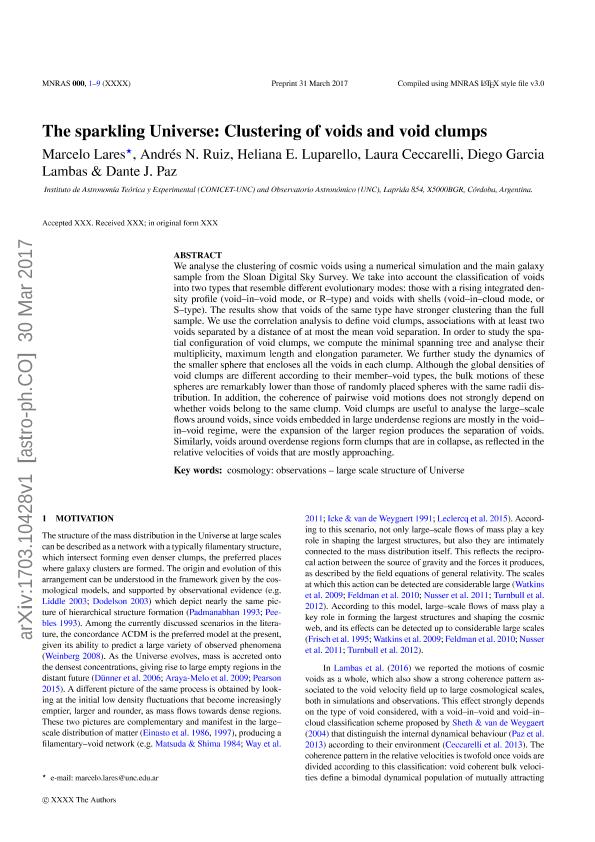Mostrar el registro sencillo del ítem
dc.contributor.author
Lares Harbin Latorre, Marcelo

dc.contributor.author
Ruiz, Andrés Nicolás

dc.contributor.author
Luparello, Heliana Estefanía

dc.contributor.author
Ceccarelli, Maria Laura

dc.contributor.author
Garcia Lambas, Diego Rodolfo

dc.contributor.author
Paz, Dante Javier

dc.date.available
2018-11-22T14:43:57Z
dc.date.issued
2017-07
dc.identifier.citation
Lares Harbin Latorre, Marcelo; Ruiz, Andrés Nicolás; Luparello, Heliana Estefanía; Ceccarelli, Maria Laura; Garcia Lambas, Diego Rodolfo; et al.; The sparkling Universe: clustering of voids and void clumps; Wiley Blackwell Publishing, Inc; Monthly Notices of the Royal Astronomical Society; 468; 4; 7-2017; 4822-4830
dc.identifier.issn
0035-8711
dc.identifier.uri
http://hdl.handle.net/11336/64913
dc.description.abstract
We analyse the clustering of cosmic voids using a numerical simulation and the main galaxy sample from the Sloan Digital Sky Survey. We take into account the classification of voids into two types that resemble different evolutionary modes: those with a rising integrated density profile (void-in-void mode, or R-type) and voids with shells (void-in-cloud mode, or S-type). The results show that voids of the same type have stronger clustering than the full sample. We use the correlation analysis to define void clumps, associations with at least two voids separated by a distance of at most the mean void separation. In order to study the spatial configuration of void clumps, we compute the minimal spanning tree and analyse their multiplicity, maximum length and elongation parameter. We further study the dynamics of the smaller sphere that encloses all the voids in each clump. Although the global densities of void clumps are different according to their member-void types, the bulk motions of these spheres are remarkably lower than those of randomly placed spheres with the same radii distribution. In addition, the coherence of pairwise void motions does not strongly depend on whether voids belong to the same clump. Void clumps are useful to analyse the large-scale flows around voids, since voids embedded in large underdense regions are mostly in the void-in-void regime, were the expansion of the larger region produces the separation of voids. Similarly, voids around overdense regions form clumps that are in collapse, as reflected in the relative velocities of voids that are mostly approaching.
dc.format
application/pdf
dc.language.iso
eng
dc.publisher
Wiley Blackwell Publishing, Inc

dc.rights
info:eu-repo/semantics/openAccess
dc.rights.uri
https://creativecommons.org/licenses/by-nc-sa/2.5/ar/
dc.subject
Cosmology: Observations
dc.subject
Cosmology: Large-Scale Structure of Universe
dc.subject.classification
Astronomía

dc.subject.classification
Ciencias Físicas

dc.subject.classification
CIENCIAS NATURALES Y EXACTAS

dc.title
The sparkling Universe: clustering of voids and void clumps
dc.type
info:eu-repo/semantics/article
dc.type
info:ar-repo/semantics/artículo
dc.type
info:eu-repo/semantics/publishedVersion
dc.date.updated
2018-10-19T17:39:19Z
dc.identifier.eissn
1745-3933
dc.journal.volume
468
dc.journal.number
4
dc.journal.pagination
4822-4830
dc.journal.pais
Reino Unido

dc.journal.ciudad
Londres
dc.description.fil
Fil: Lares Harbin Latorre, Marcelo. Consejo Nacional de Investigaciones Científicas y Técnicas. Centro Científico Tecnológico Conicet - Córdoba. Instituto de Astronomía Teórica y Experimental. Universidad Nacional de Córdoba. Observatorio Astronómico de Córdoba. Instituto de Astronomía Teórica y Experimental; Argentina
dc.description.fil
Fil: Ruiz, Andrés Nicolás. Consejo Nacional de Investigaciones Científicas y Técnicas. Centro Científico Tecnológico Conicet - Córdoba. Instituto de Astronomía Teórica y Experimental. Universidad Nacional de Córdoba. Observatorio Astronómico de Córdoba. Instituto de Astronomía Teórica y Experimental; Argentina
dc.description.fil
Fil: Luparello, Heliana Estefanía. Consejo Nacional de Investigaciones Científicas y Técnicas. Centro Científico Tecnológico Conicet - Córdoba. Instituto de Astronomía Teórica y Experimental. Universidad Nacional de Córdoba. Observatorio Astronómico de Córdoba. Instituto de Astronomía Teórica y Experimental; Argentina
dc.description.fil
Fil: Ceccarelli, Maria Laura. Consejo Nacional de Investigaciones Científicas y Técnicas. Centro Científico Tecnológico Conicet - Córdoba. Instituto de Astronomía Teórica y Experimental. Universidad Nacional de Córdoba. Observatorio Astronómico de Córdoba. Instituto de Astronomía Teórica y Experimental; Argentina
dc.description.fil
Fil: Garcia Lambas, Diego Rodolfo. Consejo Nacional de Investigaciones Científicas y Técnicas. Centro Científico Tecnológico Conicet - Córdoba. Instituto de Astronomía Teórica y Experimental. Universidad Nacional de Córdoba. Observatorio Astronómico de Córdoba. Instituto de Astronomía Teórica y Experimental; Argentina
dc.description.fil
Fil: Paz, Dante Javier. Consejo Nacional de Investigaciones Científicas y Técnicas. Centro Científico Tecnológico Conicet - Córdoba. Instituto de Astronomía Teórica y Experimental. Universidad Nacional de Córdoba. Observatorio Astronómico de Córdoba. Instituto de Astronomía Teórica y Experimental; Argentina
dc.journal.title
Monthly Notices of the Royal Astronomical Society

dc.relation.isreferencedin
info:eu-repo/semantics/reference/doi/10.1093/mnras/stx825
dc.relation.alternativeid
info:eu-repo/semantics/altIdentifier/doi/http://dx.doi.org/10.1093/mnras/stx825
dc.relation.alternativeid
info:eu-repo/semantics/altIdentifier/url/https://academic.oup.com/mnras/article-abstract/468/4/4822/3098196
Archivos asociados
